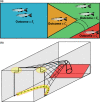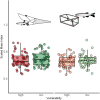Simulated trapping and trawling exert similar selection on fish morphology
- PMID: 35169454
- PMCID: PMC8840878
- DOI: 10.1002/ece3.8596
Simulated trapping and trawling exert similar selection on fish morphology
Abstract
Commercial fishery harvest can influence the evolution of wild fish populations. Our knowledge of selection on morphology is however limited, with most previous studies focusing on body size, age, and maturation. Within species, variation in morphology can influence locomotor ability, possibly making some individuals more vulnerable to capture by fishing gears. Additionally, selection on morphology has the potential to influence other foraging, behavioral, and life-history related traits. Here we carried out simulated fishing using two types of gears: a trawl (an active gear) and a trap (a passive gear), to assess morphological trait-based selection in relation to capture vulnerability. Using geometric morphometrics, we assessed differences in shape between high and low vulnerability fish, showing that high vulnerability individuals display shallower body shapes regardless of gear type. For trawling, low vulnerability fish displayed morphological characteristics that may be associated with higher burst-swimming, including a larger caudal region and narrower head, similar to evolutionary responses seen in fish populations responding to natural predation. Taken together, these results suggest that divergent selection can lead to phenotypic differences in harvested fish populations.
Keywords: FIE; fishing; geometric morphometrics; human impact; locomotion; morphology.
© 2022 The Authors. Ecology and Evolution published by John Wiley & Sons Ltd.
Conflict of interest statement
The authors declare no competing or financial interests.
Figures








References
-
- Adams, D. C. , & Otárola‐Castillo, E. (2013). Geomorph: An r package for the collection and analysis of geometric morphometric shape data. Methods in Ecology and Evolution, 4, 393–399.
Associated data
LinkOut - more resources
Full Text Sources

